University Report: Multi-Project Scheduling and Resource Allocation
VerifiedAdded on 2022/11/28
|7
|1147
|61
Report
AI Summary
This report provides an analysis of multi-project scheduling and resource allocation, focusing on the application of heuristics in project management. Part 1 of the report appraises commonly used heuristics, including an examination of the matrix structure and its impact on resource flow, organizational conflict, and the roles of higher-level officials in modifying organizational structure. The report also discusses heuristic project scheduling and scheduling rules. Part 2 reflects on the perspective of using heuristics. Part 3 examines methods for scheduling and allocating resources in multi-project environments, including mathematical analysis, duration compression, and simulation techniques. The report references research and provides insights into the practical application of various scheduling methods, and it emphasizes the importance of selecting the right techniques to optimize project outcomes.
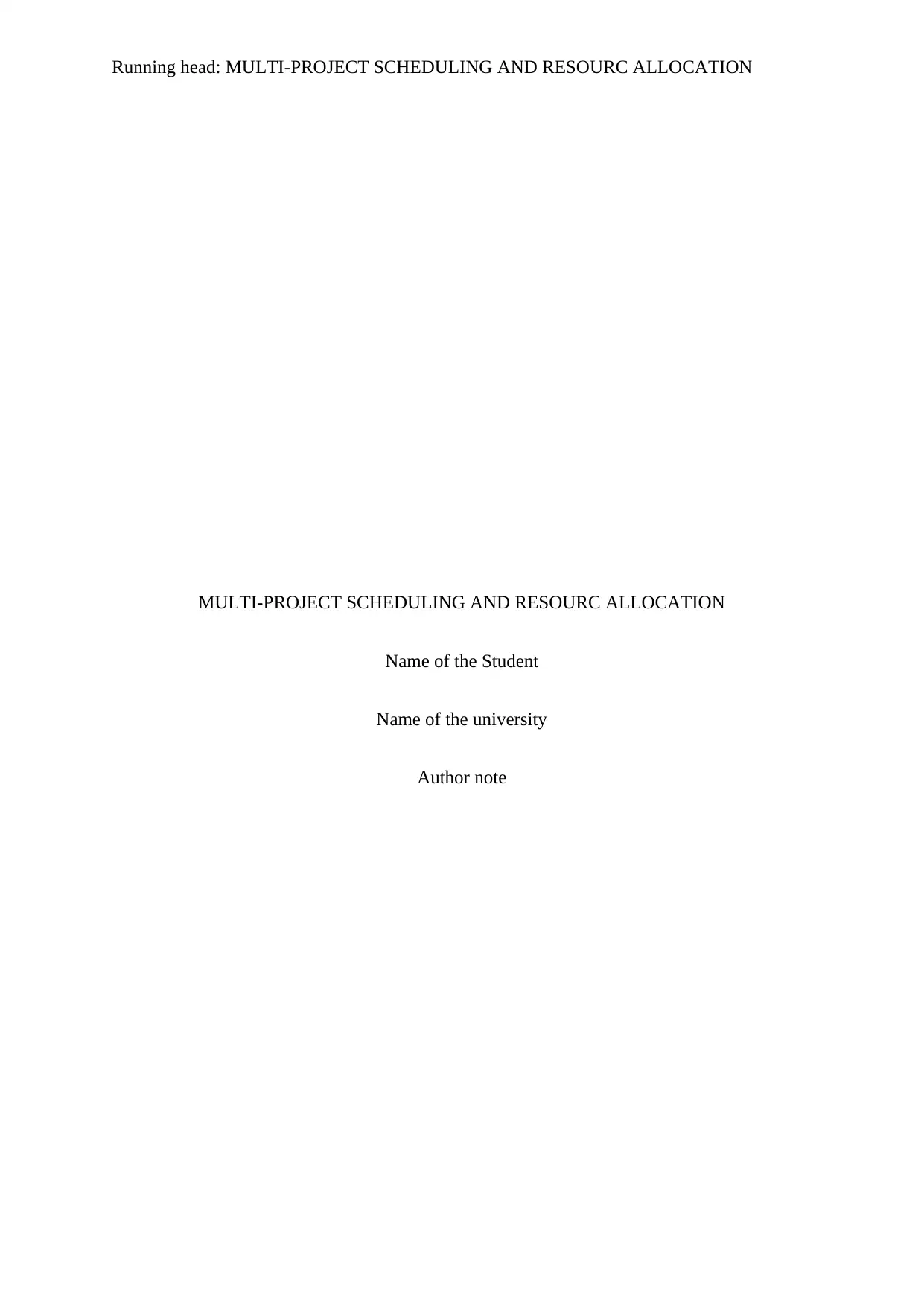
Running head: MULTI-PROJECT SCHEDULING AND RESOURC ALLOCATION
MULTI-PROJECT SCHEDULING AND RESOURC ALLOCATION
Name of the Student
Name of the university
Author note
MULTI-PROJECT SCHEDULING AND RESOURC ALLOCATION
Name of the Student
Name of the university
Author note
Paraphrase This Document
Need a fresh take? Get an instant paraphrase of this document with our AI Paraphraser

1MULTI-PROJECT SCHEDULING AND RESOURC ALLOCATION
Table of Contents
Part 1..........................................................................................................................................2
Allocation of resources under certain circumstances.................................................................2
Role of the higher level officials in changing the organizational structure...........................2
Heuristic project scheduling...................................................................................................3
Sorting out Scheduling Rules.................................................................................................3
Part 2..........................................................................................................................................3
Part 3..........................................................................................................................................4
References..................................................................................................................................5
Table of Contents
Part 1..........................................................................................................................................2
Allocation of resources under certain circumstances.................................................................2
Role of the higher level officials in changing the organizational structure...........................2
Heuristic project scheduling...................................................................................................3
Sorting out Scheduling Rules.................................................................................................3
Part 2..........................................................................................................................................3
Part 3..........................................................................................................................................4
References..................................................................................................................................5
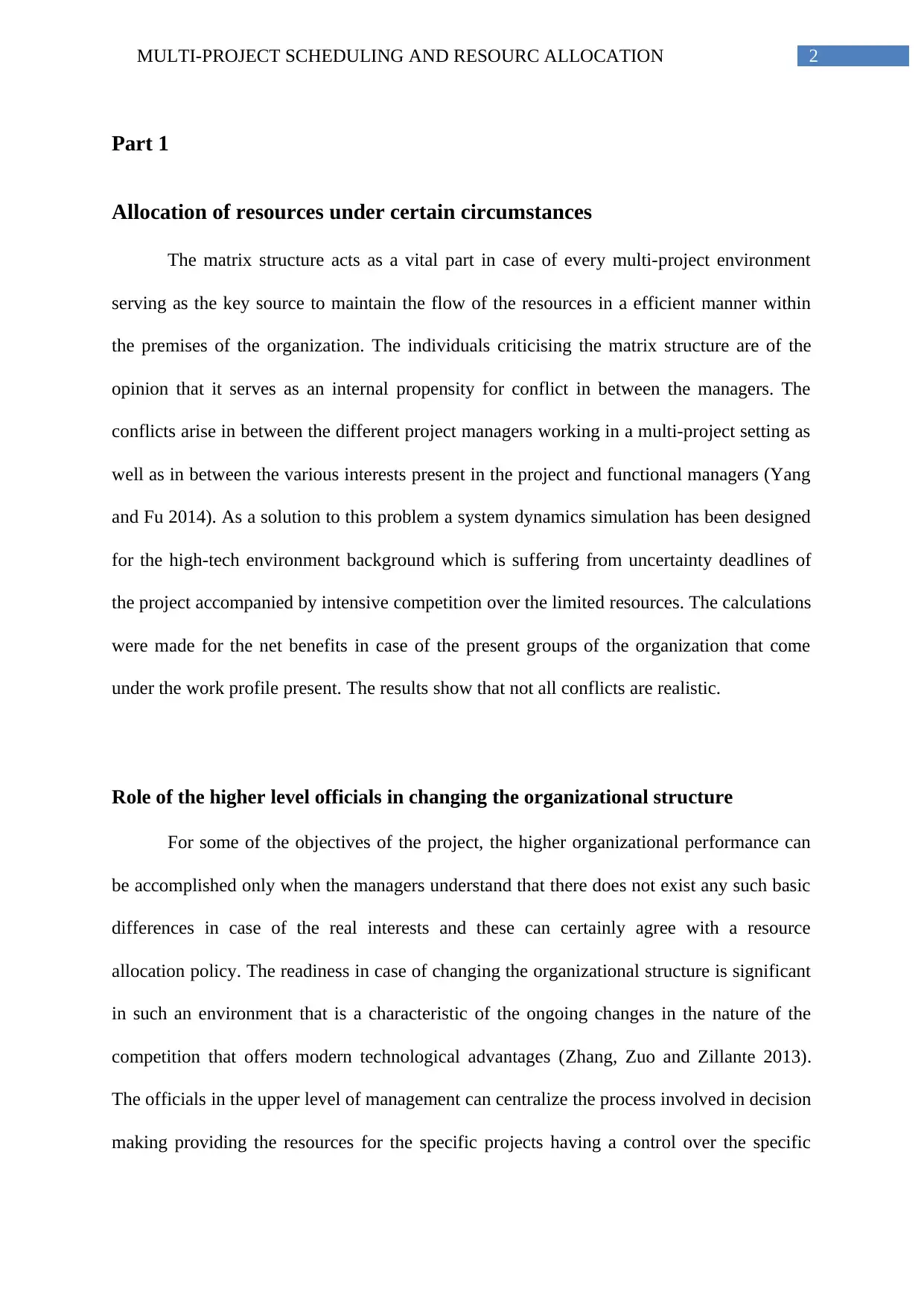
2MULTI-PROJECT SCHEDULING AND RESOURC ALLOCATION
Part 1
Allocation of resources under certain circumstances
The matrix structure acts as a vital part in case of every multi-project environment
serving as the key source to maintain the flow of the resources in a efficient manner within
the premises of the organization. The individuals criticising the matrix structure are of the
opinion that it serves as an internal propensity for conflict in between the managers. The
conflicts arise in between the different project managers working in a multi-project setting as
well as in between the various interests present in the project and functional managers (Yang
and Fu 2014). As a solution to this problem a system dynamics simulation has been designed
for the high-tech environment background which is suffering from uncertainty deadlines of
the project accompanied by intensive competition over the limited resources. The calculations
were made for the net benefits in case of the present groups of the organization that come
under the work profile present. The results show that not all conflicts are realistic.
Role of the higher level officials in changing the organizational structure
For some of the objectives of the project, the higher organizational performance can
be accomplished only when the managers understand that there does not exist any such basic
differences in case of the real interests and these can certainly agree with a resource
allocation policy. The readiness in case of changing the organizational structure is significant
in such an environment that is a characteristic of the ongoing changes in the nature of the
competition that offers modern technological advantages (Zhang, Zuo and Zillante 2013).
The officials in the upper level of management can centralize the process involved in decision
making providing the resources for the specific projects having a control over the specific
Part 1
Allocation of resources under certain circumstances
The matrix structure acts as a vital part in case of every multi-project environment
serving as the key source to maintain the flow of the resources in a efficient manner within
the premises of the organization. The individuals criticising the matrix structure are of the
opinion that it serves as an internal propensity for conflict in between the managers. The
conflicts arise in between the different project managers working in a multi-project setting as
well as in between the various interests present in the project and functional managers (Yang
and Fu 2014). As a solution to this problem a system dynamics simulation has been designed
for the high-tech environment background which is suffering from uncertainty deadlines of
the project accompanied by intensive competition over the limited resources. The calculations
were made for the net benefits in case of the present groups of the organization that come
under the work profile present. The results show that not all conflicts are realistic.
Role of the higher level officials in changing the organizational structure
For some of the objectives of the project, the higher organizational performance can
be accomplished only when the managers understand that there does not exist any such basic
differences in case of the real interests and these can certainly agree with a resource
allocation policy. The readiness in case of changing the organizational structure is significant
in such an environment that is a characteristic of the ongoing changes in the nature of the
competition that offers modern technological advantages (Zhang, Zuo and Zillante 2013).
The officials in the upper level of management can centralize the process involved in decision
making providing the resources for the specific projects having a control over the specific
⊘ This is a preview!⊘
Do you want full access?
Subscribe today to unlock all pages.

Trusted by 1+ million students worldwide
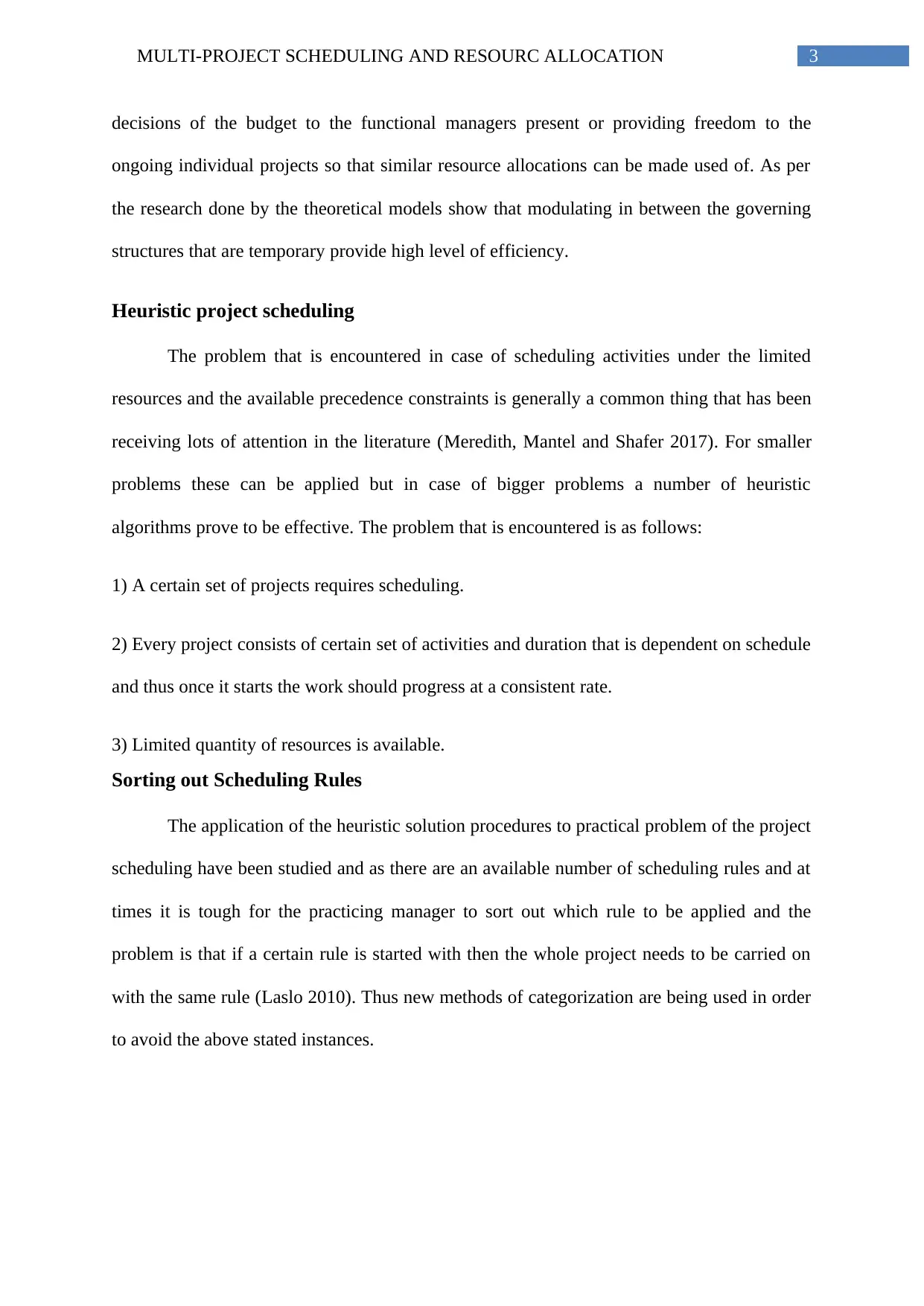
3MULTI-PROJECT SCHEDULING AND RESOURC ALLOCATION
decisions of the budget to the functional managers present or providing freedom to the
ongoing individual projects so that similar resource allocations can be made used of. As per
the research done by the theoretical models show that modulating in between the governing
structures that are temporary provide high level of efficiency.
Heuristic project scheduling
The problem that is encountered in case of scheduling activities under the limited
resources and the available precedence constraints is generally a common thing that has been
receiving lots of attention in the literature (Meredith, Mantel and Shafer 2017). For smaller
problems these can be applied but in case of bigger problems a number of heuristic
algorithms prove to be effective. The problem that is encountered is as follows:
1) A certain set of projects requires scheduling.
2) Every project consists of certain set of activities and duration that is dependent on schedule
and thus once it starts the work should progress at a consistent rate.
3) Limited quantity of resources is available.
Sorting out Scheduling Rules
The application of the heuristic solution procedures to practical problem of the project
scheduling have been studied and as there are an available number of scheduling rules and at
times it is tough for the practicing manager to sort out which rule to be applied and the
problem is that if a certain rule is started with then the whole project needs to be carried on
with the same rule (Laslo 2010). Thus new methods of categorization are being used in order
to avoid the above stated instances.
decisions of the budget to the functional managers present or providing freedom to the
ongoing individual projects so that similar resource allocations can be made used of. As per
the research done by the theoretical models show that modulating in between the governing
structures that are temporary provide high level of efficiency.
Heuristic project scheduling
The problem that is encountered in case of scheduling activities under the limited
resources and the available precedence constraints is generally a common thing that has been
receiving lots of attention in the literature (Meredith, Mantel and Shafer 2017). For smaller
problems these can be applied but in case of bigger problems a number of heuristic
algorithms prove to be effective. The problem that is encountered is as follows:
1) A certain set of projects requires scheduling.
2) Every project consists of certain set of activities and duration that is dependent on schedule
and thus once it starts the work should progress at a consistent rate.
3) Limited quantity of resources is available.
Sorting out Scheduling Rules
The application of the heuristic solution procedures to practical problem of the project
scheduling have been studied and as there are an available number of scheduling rules and at
times it is tough for the practicing manager to sort out which rule to be applied and the
problem is that if a certain rule is started with then the whole project needs to be carried on
with the same rule (Laslo 2010). Thus new methods of categorization are being used in order
to avoid the above stated instances.
Paraphrase This Document
Need a fresh take? Get an instant paraphrase of this document with our AI Paraphraser
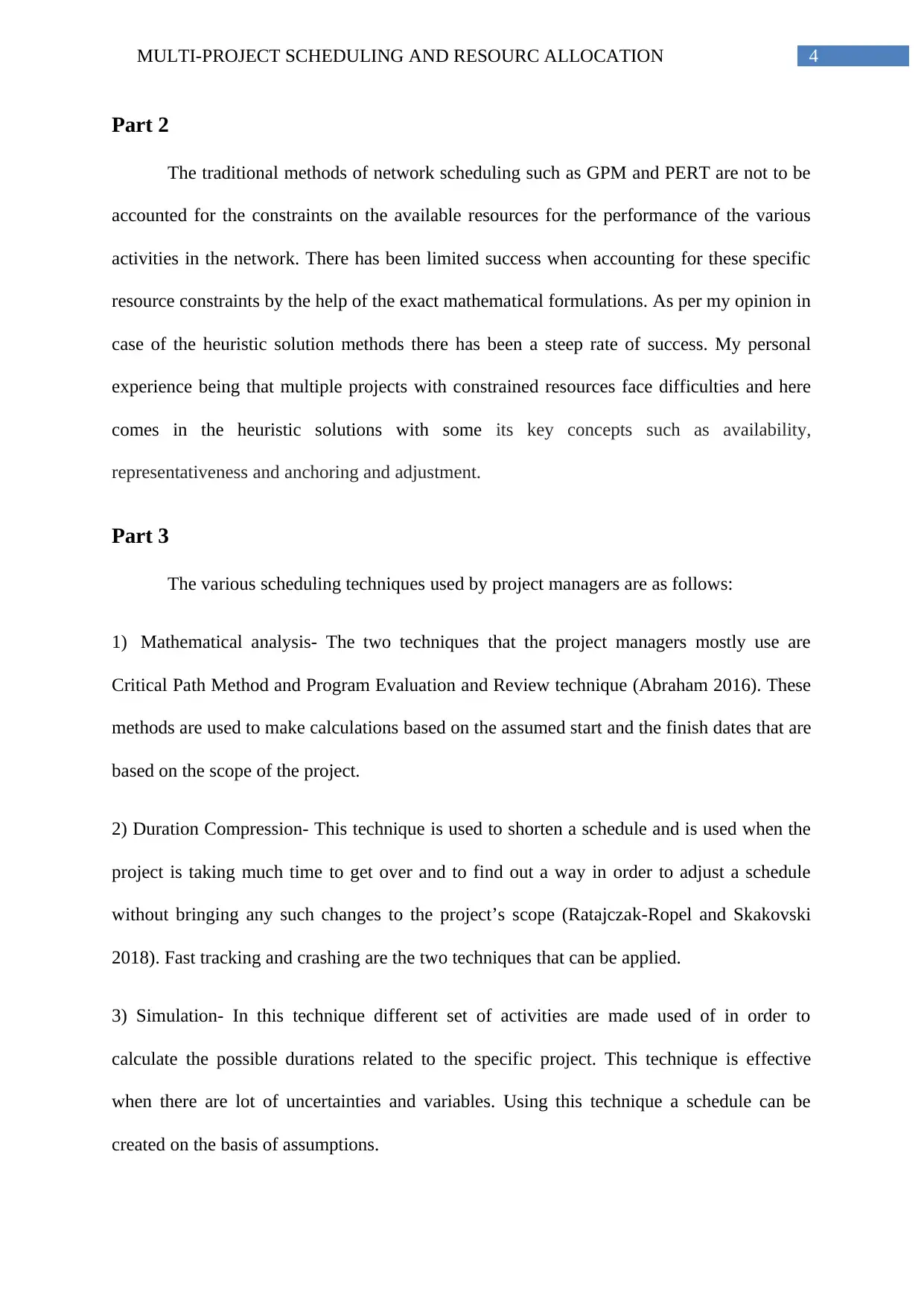
4MULTI-PROJECT SCHEDULING AND RESOURC ALLOCATION
Part 2
The traditional methods of network scheduling such as GPM and PERT are not to be
accounted for the constraints on the available resources for the performance of the various
activities in the network. There has been limited success when accounting for these specific
resource constraints by the help of the exact mathematical formulations. As per my opinion in
case of the heuristic solution methods there has been a steep rate of success. My personal
experience being that multiple projects with constrained resources face difficulties and here
comes in the heuristic solutions with some its key concepts such as availability,
representativeness and anchoring and adjustment.
Part 3
The various scheduling techniques used by project managers are as follows:
1) Mathematical analysis- The two techniques that the project managers mostly use are
Critical Path Method and Program Evaluation and Review technique (Abraham 2016). These
methods are used to make calculations based on the assumed start and the finish dates that are
based on the scope of the project.
2) Duration Compression- This technique is used to shorten a schedule and is used when the
project is taking much time to get over and to find out a way in order to adjust a schedule
without bringing any such changes to the project’s scope (Ratajczak-Ropel and Skakovski
2018). Fast tracking and crashing are the two techniques that can be applied.
3) Simulation- In this technique different set of activities are made used of in order to
calculate the possible durations related to the specific project. This technique is effective
when there are lot of uncertainties and variables. Using this technique a schedule can be
created on the basis of assumptions.
Part 2
The traditional methods of network scheduling such as GPM and PERT are not to be
accounted for the constraints on the available resources for the performance of the various
activities in the network. There has been limited success when accounting for these specific
resource constraints by the help of the exact mathematical formulations. As per my opinion in
case of the heuristic solution methods there has been a steep rate of success. My personal
experience being that multiple projects with constrained resources face difficulties and here
comes in the heuristic solutions with some its key concepts such as availability,
representativeness and anchoring and adjustment.
Part 3
The various scheduling techniques used by project managers are as follows:
1) Mathematical analysis- The two techniques that the project managers mostly use are
Critical Path Method and Program Evaluation and Review technique (Abraham 2016). These
methods are used to make calculations based on the assumed start and the finish dates that are
based on the scope of the project.
2) Duration Compression- This technique is used to shorten a schedule and is used when the
project is taking much time to get over and to find out a way in order to adjust a schedule
without bringing any such changes to the project’s scope (Ratajczak-Ropel and Skakovski
2018). Fast tracking and crashing are the two techniques that can be applied.
3) Simulation- In this technique different set of activities are made used of in order to
calculate the possible durations related to the specific project. This technique is effective
when there are lot of uncertainties and variables. Using this technique a schedule can be
created on the basis of assumptions.

5MULTI-PROJECT SCHEDULING AND RESOURC ALLOCATION
.
.
⊘ This is a preview!⊘
Do you want full access?
Subscribe today to unlock all pages.

Trusted by 1+ million students worldwide
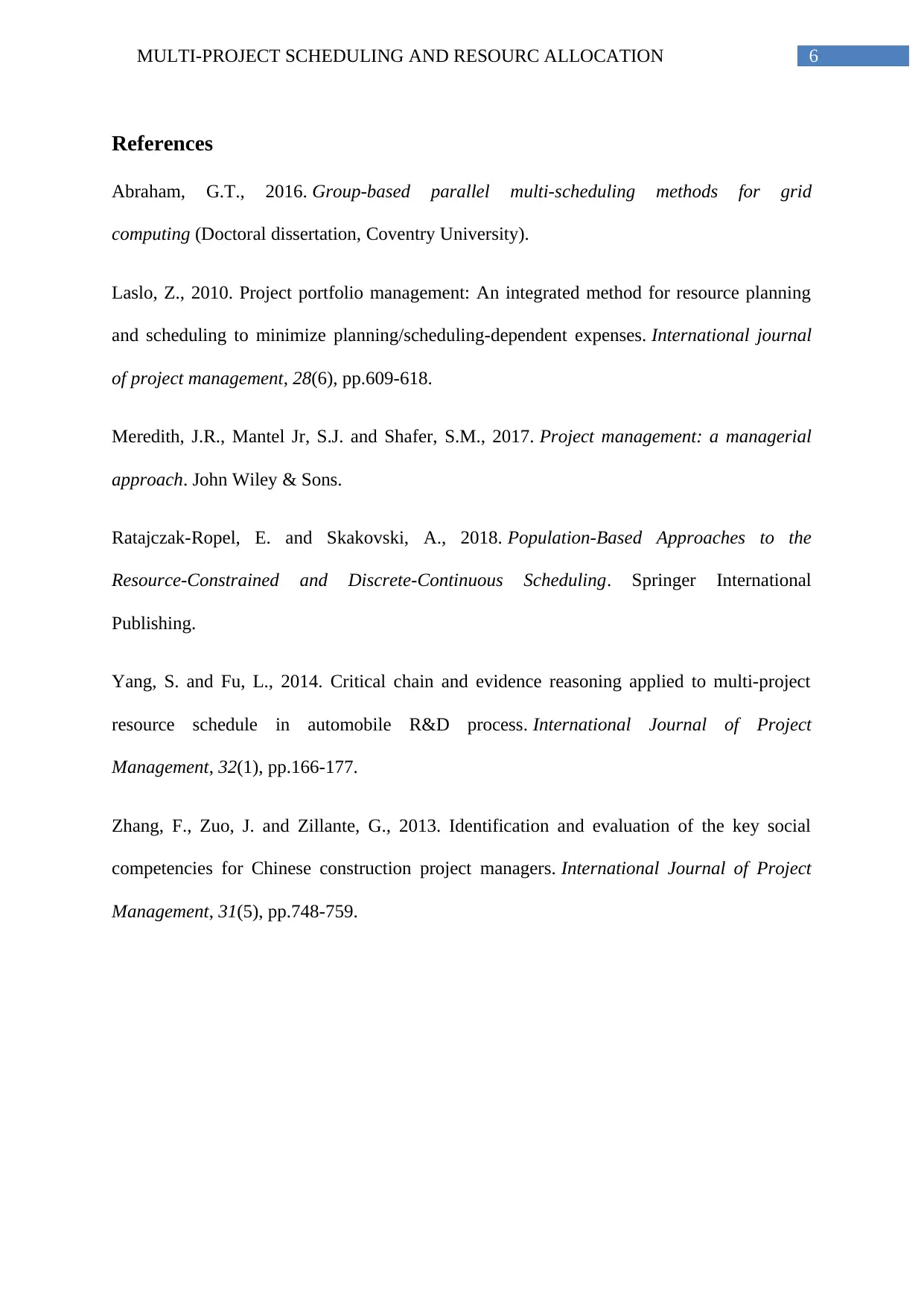
6MULTI-PROJECT SCHEDULING AND RESOURC ALLOCATION
References
Abraham, G.T., 2016. Group-based parallel multi-scheduling methods for grid
computing (Doctoral dissertation, Coventry University).
Laslo, Z., 2010. Project portfolio management: An integrated method for resource planning
and scheduling to minimize planning/scheduling-dependent expenses. International journal
of project management, 28(6), pp.609-618.
Meredith, J.R., Mantel Jr, S.J. and Shafer, S.M., 2017. Project management: a managerial
approach. John Wiley & Sons.
Ratajczak-Ropel, E. and Skakovski, A., 2018. Population-Based Approaches to the
Resource-Constrained and Discrete-Continuous Scheduling. Springer International
Publishing.
Yang, S. and Fu, L., 2014. Critical chain and evidence reasoning applied to multi-project
resource schedule in automobile R&D process. International Journal of Project
Management, 32(1), pp.166-177.
Zhang, F., Zuo, J. and Zillante, G., 2013. Identification and evaluation of the key social
competencies for Chinese construction project managers. International Journal of Project
Management, 31(5), pp.748-759.
References
Abraham, G.T., 2016. Group-based parallel multi-scheduling methods for grid
computing (Doctoral dissertation, Coventry University).
Laslo, Z., 2010. Project portfolio management: An integrated method for resource planning
and scheduling to minimize planning/scheduling-dependent expenses. International journal
of project management, 28(6), pp.609-618.
Meredith, J.R., Mantel Jr, S.J. and Shafer, S.M., 2017. Project management: a managerial
approach. John Wiley & Sons.
Ratajczak-Ropel, E. and Skakovski, A., 2018. Population-Based Approaches to the
Resource-Constrained and Discrete-Continuous Scheduling. Springer International
Publishing.
Yang, S. and Fu, L., 2014. Critical chain and evidence reasoning applied to multi-project
resource schedule in automobile R&D process. International Journal of Project
Management, 32(1), pp.166-177.
Zhang, F., Zuo, J. and Zillante, G., 2013. Identification and evaluation of the key social
competencies for Chinese construction project managers. International Journal of Project
Management, 31(5), pp.748-759.
1 out of 7
Related Documents
Your All-in-One AI-Powered Toolkit for Academic Success.
+13062052269
info@desklib.com
Available 24*7 on WhatsApp / Email
![[object Object]](/_next/static/media/star-bottom.7253800d.svg)
Unlock your academic potential
Copyright © 2020–2025 A2Z Services. All Rights Reserved. Developed and managed by ZUCOL.



